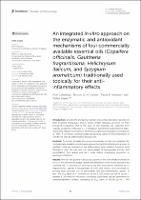Please use this identifier to cite or link to this item:
https://repositorio.usj.es/handle/123456789/1117
| Title: | An integrated in vitro approach on the enzymatic and antioxidant mechanisms of four commercially available essential oils (Copaifera officinalis, Gaultheria fragrantissima, Helichrysum italicum, and Syzygium aromaticum) traditionally used topically for their anti-inflammatory effects |
| Authors: | Cebollada, Pilar Gomes, N.M. 
Andrade, Paula B. López Ramos, Víctor 

|
| Keywords: | Caryophyllene; Eugenol; Methyl salicylate; Pinene; Syzygium aromaticum |
| Issue Date: | 29-Jan-2024 |
| Publisher: | Frontiers Media |
| Citation: | Cebollada P, Gomes NGM, Andrade PB and López V (2024), An integrated in vitro approachon the enzymatic and antioxidant mechanisms of four commercially available essential oils (Copaifera officinalis, Gaultheria fragrantissima, Helichrysum italicum, and Syzygiumaromaticum) traditionally used topically for theiranti-inflammatory effects. Front. Pharmacol.14:1310439.doi: 10.3389/fphar.2023 |
| Abstract: | Introduction: Despite the increasing number of essential oils being reported on their potential therapeutic effects, some remain relatively unknown on their biological properties. That is the case of the essential oils obtained from copaiba (Copaifera officinalis L.), wintergreen (Gaultheria fragrantissima Wall.), everlasting (Helichrysum italicum (Roth) G.Don) and clove (Syzygium aromaticum (L.) Merr. & L.M.Perry), commonly labelled as being useful on the amelioration of conditions with an inflammatory background. Methods: To further broaden the current knowledge on the four essential oils, commercially available samples were approached on their effects upon a series of mediators that are involved on the inflammatory and oxidative response, both through in vitro cell-free and cell-based assays (5-lipoxygenase activity, lipid peroxidation, free radical and nitric oxide radical scavenging properties or tyrosinase inhibition). Results: The four oils proved to be active at some of the concentrations tested in most of the performed assays. Significant differences were found between the essential oils, S. aromaticum proving to tbe the most active, followed by G. fragrantissima against 5-lipoxygenase (5-LOX) and linoleic acid peroxidation, proving their potential use as antioxidants and anti-inflammatory agents. In fact, the IC50 value of S. aromaticum in the 5-LOX assay was 62.30 μg mL−1. Besides S. aromaticum efficiently scavenged superoxide radicals generated by xanthine/xanthine oxidase, displaying an IC50 value of 135.26 μg mL−1. The essential oil obtained from H. italicum exhibited a significant decrease in the nitric oxide levels on BV-2 cells, showing its potential as a cytoprotective agent against toxic damage. Copaiba oil ranked first as the most potent tyrosinase inhibitor, exhibiting an IC50 98.22 μg mL−1. Conclusion: More studies are needed to describe the essential oils properties, but these results confirm the potential of these essential oils as anti-inflammatory and antioxidant agents. |
| URI: | https://repositorio.usj.es/handle/123456789/1117 |
| ISSN: | 1663-9812 |
| Appears in Collections: | Artículos de revistas |
Files in This Item:
| File | Description | Size | Format | |
|---|---|---|---|---|
| An integrated in vitro.pdf | 2,04 MB | Adobe PDF |  View/Open |
This item is licensed under a Creative Commons License

